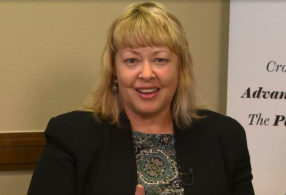October 19, 2016
In January 2010, 11 men and women boarded a flight from New York to the tiny island of Grenada, a palm-treed Caribbean paradise ringed by white sand beaches and a crystal turquoise sea. But the group wasn’t on vacation. This was a team from New York University’s College of Dentistry, and they’d come to assess the dental health of Grenada’s children. For the next two weeks, they dragged tanks of compressed air, lights and other equipment into schools, transforming classrooms into makeshift dentist offices. They examined 1,075 kids from two age groups—six- to eight-year-old elementary school children and young teens, 14 and 15 years old—and they made an alarming discovery. Eighty-three percent had cavities. And not just one, but an average of nine: Grenada had one of the highest rates in the world.
There were a host of reasons. Many of the country’s 26,000 children had never seen a dentist and didn’t own a toothbrush, or if they did, they didn’t brush regularly. With a growing junk food industry, they drank lots of soda and ate sugary snacks—which were even sold in schools. The country had no water fluoridation program.
The situation amounted to a crisis that the island’s dozen or so dentists could not fight alone. But there was hope. Grenada had a fairly sophisticated health network, a strong educational system, and had the political will to turn the situation around.
So NYU worked with the Ministries of Health and Education, dental professionals, and others to design a national “Smile Grenada” program focused on early-childhood prevention—that would turn schools into dental health centers.
Professor Mark Wolff, who spearheaded the initiative, realized early on that the success of the program relied on teachers. So he and his team went into schools, training hundreds of teachers on how to lead a daily, two-minute tooth brushing regimen with their students and encourage healthy eating. They also demonstrated how to apply fluoride varnish to students’ teeth, which was done three times a year to protect against the acids that cause cavities. Students were given toothbrushes, which were kept at school. Each academic year, Colgate-Palmolive donated 26,000 toothbrushes, 52,000 tubes of toothpaste, and 78,000 doses of fluoride varnish to the program.
Workshops for dental and medical professionals and forums for parents helped to make oral hygiene a priority nationwide, and dental exams revealed the program’s astonishing success in just two and a half years. The incidence of new cavities in school-aged children had dropped by a whopping 75 percent. “It was the perfect meeting of the willing educator and the child in need,” Wolff says, adding that tooth decay is essentially a disease of ignorance—and changing dental habits is key. The program is now being replicated in the Philippines and in China.
The Scope of the Problem
Despite being largely preventable, dental disease is a global scourge that affects 60 to 90 percent of schoolchildren and nearly all adults, according to the World Health Organization—and plaque is the enemy. The mouth naturally teems with some 500 species of bacteria. These microorganisms form communities, melding with bits of food to cover teeth and gums in sticky plaque also known as “biofilm.” The microbes produce acids that rot teeth, and some types can invade and inflame the gums, creating tiny ulcers. Left unattended—without a regimen that includes brushing with bacteria-fighting toothpaste, flossing and rinsing—invader bacteria advance further into the gums, creating severe periodontal disease that destroys both gum tissue and bone. Worldwide, periodontal disease causes up to 20 percent of adults from 35 to 44 to lose teeth—and has been implicated in broader health problems. It’s been shown to affect the ability of diabetic patients to control blood sugar, has been correlated with heart disease, complications during pregnancy, and other conditions.
Tooth decay brings its own set of health impacts, impairing the ability to eat. In the United Kingdom, cavities send more children to the hospital than any other ailment. In 2014 and 2015, English children under the age of nine had 179,218 teeth pulled, according to the British Dental Association. In Africa, as many as four out of five school-aged children have both cavities and gum disease, according to WHO estimates. In Greece, 86.8 percent of 5-year-olds suffered dental problems.
In the U.S., tooth decay remains the most common chronic childhood disease: more than half of teenagers have had cavities. Meanwhile, many seniors are forced to delay or forego dental treatments because of cost. According to a 2013 survey from the American Dental Association’s Health Policy Institute, amalgam fillings cost $86 to $326, porcelain crowns run from $962 to $1,070 and root canals range from $511 to $1,274. About 114 million Americans lack dental coverage; 67.7 million are under age 65; 70 percent of adults 65 and older are uninsured.
Taking the Team Approach
Dealing with a public health problem of this magnitude requires innovative, creative, collaborative solutions. Some efforts focus on specific issues, like cavities. Traditionally, when decay etches a cavity into a tooth, it’s required drilling and a filling. Now, some dentists are trying to intervene sooner. Tooth decay occurs slowly enough that it can be stopped, or even reversed, before acids secreted by mouth bacteria erode calcium from tooth enamel. Ions dissolved in saliva naturally replace lost minerals, but if acids abound and decay begins, simple “re-mineralization treatments” like fluoride varnish can reverse the process.
In a study that tracked 1,000 high-risk patients, Sydney University researchers found that if decay was caught early and a high-concentration fluoride varnish used, the need for fillings fell by 80 percent.
But there is also a broader, sweeping shift in the way healthcare is now being defined that is bridging the long-standing divide between dentistry and medicine. With mounting research linking the health of the mouth with that of the entire body, there is a growing realization that oral care is a health issue that needs to be considered by all health practitioners, says Caswell Evans, associate dean for prevention and public health sciences at the University of Illinois at Chicago.
In 2000, when former U.S. Surgeon General David Satcher put oral health care on the national agenda with his landmark report, Oral Health in America, dentistry sat within its own silo. Most medical personnel, public health professionals and educators included little, if any, consideration of oral health in their practices, standards or curriculums. “That has begun to change in some very dramatic ways, with a lot of attention now being paid to cross-silo education,” Evans says. As a result, the barriers between the two disciplines are slowly coming down, with professionals from nurses and pharmacy staff to social workers now including oral health in their service regimens.
“Inter-professional” education is changing the game. Since 2014, New York University has convened nursing, dental and medical faculty and students to jointly assess the mouth—the teeth, gums, tongue and palate—to learn diagnosis and treatment of oral-systemic health issues, such as diabetes. Their studies include classroom learning, simulations and hands-on clinical experiences. In another program at the University of California, San Francisco, 149 first-year medical students “cross-trained” during the fall of 2015, learning how to do basic oral health screening and apply fluoride varnish.

David Satcher says that there are broader social and public health implications. Integrating primary medical care and dentistry would improve oral health for many, including those who need it most. That list includes both the young and old: low-income children whose parents can’t afford to take time off from work to bring them to the dentist and elderly patients who can’t drive and need help getting to appointments. Within an integrated model, community healthcare centers could offer both primary medical services and basic dental care. But for the moment, the challenge is determining who will pay for it.
Early intervention could start in the pediatrician’s office. “Young children see a pediatrician about eight times or more before ever visiting a dentist, which is oftentimes too late, as cavities may already be present,” says Margherita Fontana, a professor at the University of Michigan School of Dentistry. Her department developed a questionnaire to identify toddlers who are most at risk for cavities, which is currently being tested in four states. As part of a normal well-child visit, parents fill out an assessment sheet, answering questions on how often they brush their child’s teeth, what their kids snack on, whether the bottle their child takes into bed at night contains juice, water or another drink, and more. This clearly identifies problems and gives doctors the opportunity to discuss healthy habits with parents.
Planting the Seed for Better Nutrition
In his report, Satcher emphasized the importance of diet in preventing oral disease, which he says remains a major challenge today. He noted that poor oral health is exacerbated by smoking and high intake of sugar and alcohol. But nutrition affects oral health from birth, and socioeconomics is a big factor. “Children living in poverty are less likely to get the kind of nutrition that’s important for development of their teeth,” he says—and it’s a global problem.
Beginning in 2001, Karen Sokal-Gutierrez saw the effects first-hand while volunteering as a public health physician with a community health organization in rural El Salvador. She’d worked in similar Latin American villages in the Peace Corps in Ecuador from 1978 to 1980, but in the intervening 20-some years, sugary processed snacks and drinks had replaced fruits and other locally-produced foods in the markets. When she arrived in El Salvador, she was shocked by the difference: many children had blackened teeth. In her old Peace Corps photos, the kids had pearly smiles.
By 2004, she’d launched the Global Children’s Oral Health and Nutrition Program with private donations and a small grant from the University of California Berkeley’s School of Public Health, where she is a clinical professor. When she and her team did their first community-wide assessment, they discovered that 85 percent of the children had untreated tooth decay, and nearly half suffered mouth pain. So they targeted prevention for babies and young children—and educated local community health workers, parents and children on both oral health and nutrition. They also engaged the kids in creative ways. A community health worker became the “Bottle Fairy,” donning a shimmering dress with wings and a wand to “fly in” during community dental camps to encourage toddlers to trade in their bottles for a new sippy cup, which can limit tooth decay.
The program has since expanded. Sokal-Gutierrez, her colleague Susan Ivey, and undergraduate and graduate student volunteers now carry duffle bags of toothbrushes, toothpaste, and a big pink-and-white teaching model of a mouth to Ecuador, Nepal, Vietnam and India. These countries, too, were in need of assistance. For example, in Nepal, two-thirds of the children had untreated tooth decay and some 40 percent were malnourished. (In response, some educators have now banned junk food from school.)
In Ecuador, many children had bad teeth and also carried a dual legacy of poor diet: obesity and malnutrition. Sokal-Gutierrez recounted the case of a five-year-old boy she examined in a small Ecuadorian town. All of his 20 baby teeth were decayed and he weighed about as much as an American two-year-old, so thin, pallid, and lethargic that he “looked like a child dying of AIDS,” she said. His parents owned the village tienda and he had limitless access to the candy shelves. She has also observed infants given soda in baby bottles. In the slums of Mumbai, India, health workers told her about young children who were given “candy for breakfast, a chocolate bar for lunch and a bag of chips for dinner.”
Raising awareness about nutrition and oral health has had lasting impact, Sokal-Gutierrez says. Six years into the El Salvador program, kids were brushing their teeth and eating less junk. Decay dropped to 50 percent, pain to 22 percent, and malnutrition fell from 16 percent to two percent. In each country, the programs are being transferred to nonprofits and government agencies.
Prevention for an Aging Population
The elderly are another highly underserved demographic. In the U.S., about 10,000 baby boomers turn 65 each day—and many who have dental insurance lose it when they retire. One-fifth of people over 75 haven’t seen a dentist in five years, and globally, almost a third of people aged 65 to 74 have none of their original teeth.
Some countries are now creating incentives for dentists to be proactive. “The real challenge now is to… reward the maintenance of really good health through prevention that is research-based,” says Jimmy Steele, professor at Newcastle University School of Dental Sciences. The United Kingdom’s National Health Service is doing just that, offering financial rewards to dentists for preventing cavities and oral disease. Singapore also recently made great strides: its National Dental Centre just opened a Geriatric Special Care Dentistry Clinic that can accommodate bedridden and wheelchair-bound patients, and the Ministry of Health is now offering scholarships to train dentists in geriatric and special needs care.
In the U.S., the nonprofit Center for Oral Health is currently assessing dental problems among California’s elderly. Preliminary results show that 38 percent of people in the state’s long-term care facilities have lost all of their original teeth; nearly half have at least one untreated cavity; and about one in seven need urgent care.
In some states, including Oregon and California, elderly patients who can’t drive or are too ill to visit a dentist can get care from a dental hygienist at home. Desiree Strawn, who runs Amor Dental Hygiene Mobile Service in Culver, Oregon, explains that before seeing her, many of her patients hadn’t received regular cleanings—and their inflamed gums were exacerbating a range of other health issues. During house calls, she cleans teeth and encourages good oral hygiene, including brushing, flossing and rinsing. Her work sometimes involves physical therapy of sorts, like helping elderly patients relearn how to maneuver a toothbrush.
Many new avenues are bringing forth novel ways to prevent oral disease, but for now, there is a growing, universal urgency to address the current crisis. In the U.S. alone, nearly 30 percent of 15,000 adults surveyed across all income levels said life is “very often” or “occasionally” less satisfying because of the condition of their mouth or teeth. Nearly one in four adults said they avoid smiling because of the state of their mouth, according to a June 2016 American Dental Association Health Policy Institute report. The authors urged policymakers to re-evaluate the separation of the mouth from the rest of the body in both state and federal healthcare policy—and to consider the growing data linking oral health to physical, social and economic well-being. As Caswell Evans explains, much more can be done to improve the state of oral health around the world. “A lot of progress has been made, but there’s a lot of room for improvement,” he says.
Credit: Michael Glenwood Gibbs, NYU Dentistry


















